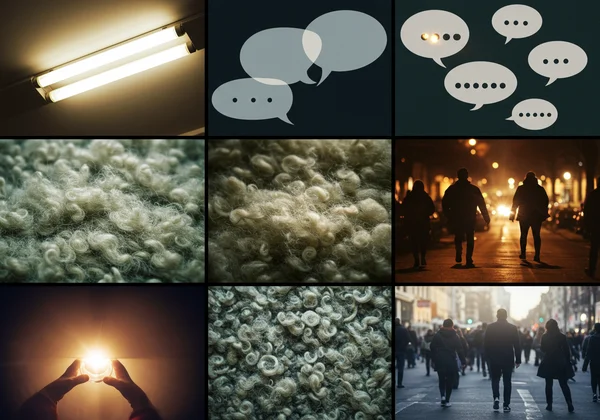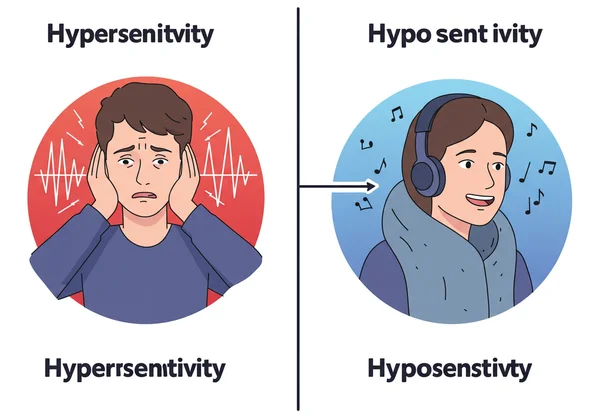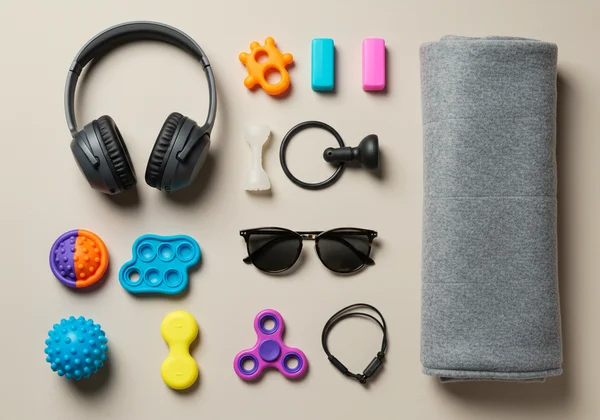Autistic Test & Sensory Overload: Understanding & Coping
Do you ever feel like the world is turned up too loud? That the lights are too bright, or the tag on your shirt feels unbearable? You're not alone. This feeling of being completely overwhelmed by your senses is known as sensory overload, and it's a common experience for many autistic individuals. If you've ever wondered, What does sensory overload feel like?, this guide is for you. We'll explore the connection between sensory issues and the autistic test, providing clear explanations and practical strategies to help you navigate and manage these intense experiences.
Understanding your sensory profile is a key part of self-discovery. For many, this journey begins with seeking information and seeing if their experiences align with known autistic traits. A confidential online autistic test can be a valuable first step, offering insights that empower you to explore further. This article will serve as your guide to understanding one of the most common, yet often misunderstood, aspects of the autistic experience.
Disclaimer: This article is for informational purposes only. The tools and information on this site are intended for preliminary self-screening and are not a substitute for a professional medical diagnosis. Always consult a qualified healthcare professional for any health concerns or before making any decisions related to your health or treatment.
What is Autism Sensory Overload?
Imagine your brain is a central processing unit (CPU) for a computer. It constantly receives data from your five senses—sight, sound, touch, taste, and smell—plus internal senses like balance (vestibular) and body awareness (proprioception). In a neurotypical brain, there's an effective filter that prioritizes important information and pushes irrelevant data into the background. For many autistic people, this filter doesn't work the same way.
Autism sensory overload happens when the brain receives more sensory information than it can effectively process at one time. The filter is down, and everything comes flooding in at once. The gentle hum of a refrigerator becomes as loud as a conversation, the flicker of a fluorescent light is a strobe, and the light touch of a stranger's arm feels like an electric shock. This flood of unprocessed information can be disorienting, distressing, and completely exhausting.

What Does Sensory Overload Feel Like? Experiencing Too Much
Describing sensory overload can be difficult, as it's a deeply personal experience. However, many autistic people report similar themes. It can feel like a complete system crash. Physically, you might experience a racing heart, sweating, dizziness, or nausea. Emotionally, it can trigger intense anxiety, irritability, panic, or an overwhelming urge to flee the situation.
Many describe a feeling of being trapped or suffocated by their environment. The world can become distorted, with sounds blurring into an indecipherable roar and lights becoming painfully bright. This can lead to a "meltdown" (an intense outward expression of distress) or a "shutdown" (an internal withdrawal where a person may become non-verbal or unresponsive). It’s the brain's way of saying, "I've had enough," and forcing a hard reset. If these feelings resonate, exploring them through an am i autistic test can provide a framework for understanding.
Common Sensory Triggers for Autistic Individuals
Sensory triggers are highly individual, but some are more common than others. Recognizing your specific triggers is the first step toward managing them. Here are some examples across different senses:
-
Auditory: Loud, sudden noises (sirens, alarms), overlapping conversations, high-pitched sounds, persistent background humming.
-
Visual: Bright or flickering fluorescent lights, cluttered environments, flashing screens, complex patterns, direct sunlight.
-
Tactile: Unexpected touch, certain clothing textures (like wool) or tags, sticky or greasy substances, specific water temperatures.
-
Olfactory (Smell): Strong perfumes or air fresheners, cleaning products, specific food smells.
-
Gustatory (Taste): "Mushy" or mixed food textures, overly strong flavors, the feeling of certain foods in the mouth.
-
Vestibular & Proprioceptive: Crowds where people are bumping into you, swings, escalators, or situations that challenge your sense of balance and body position.

Understanding Sensory Processing Differences in Autism
These sensory challenges stem from fundamental differences in how the autistic brain is wired. This isn't a flaw; it's a different way of experiencing the world. Sensory processing disorder autism is a term often used to describe these challenges, highlighting how the brain perceives and responds to sensory input differently. Understanding these differences is key to developing empathy and effective coping strategies.
Exploring these differences can be part of a larger journey of self-identity. Many adults who have felt "different" their whole lives find clarity when they start researching these traits. An autistic test for adults can be an insightful tool in this process.
Hypersensitivity vs. Hyposensitivity: A Spectrum of Experiences
Sensory processing differences in autism exist on a spectrum. An individual can be over-sensitive (hyper) to some stimuli and under-sensitive (hypo) to others.
- Hypersensitivity (Over-responsive): This is the classic "sensory overload" experience. A person is highly sensitive to sensory input, and even low levels of stimulation can feel overwhelming. This is the person who needs sunglasses indoors or wears noise-canceling headphones in the grocery store.
- Hyposensitivity (Under-responsive): This is the opposite. A person may have a high tolerance for pain, seem oblivious to loud noises, or fail to notice strong smells. To feel regulated, they may actively seek out intense sensory experiences, like listening to loud music, eating spicy food, or engaging in high-impact physical activity like jumping or crashing into things.
It's common for an autistic person to have a mixed profile. For example, someone might be hypersensitive to sound but hyposensitive to touch, leading them to seek out the deep pressure of a weighted blanket to calm down.

The Neurological Basis of Autistic Sensory Challenges
The neurological basis for these sensory differences is an active area of research. Current theories suggest it relates to connectivity within the brain. Some studies indicate that local connections between neurons may be stronger in autistic brains, while long-range connections are weaker. This could mean the brain over-processes fine details from the senses but struggles to integrate them into a coherent whole.
Essentially, the brain's "gatekeeper" for sensory information may be less effective at filtering out non-essential data. This leads to a state of constant high alert and rapid depletion of mental energy. Understanding this neurological foundation helps reframe sensory issues not as a behavioral choice, but as a legitimate physiological response. A comprehensive autistic traits test often includes questions that touch upon these sensory experiences.
Effective Strategies for Coping with Sensory Triggers
While you can't change how your brain is wired, you can develop powerful strategies for coping with sensory triggers. The goal is to reduce overwhelming input and create opportunities for your nervous system to regulate. This is about empowerment and taking control of your environment.
Creating Sensory-Friendly Environments
Modifying your surroundings can make a world of difference. At home, you can create a "sensory sanctuary"—a quiet, calming space you can retreat to when feeling overwhelmed. This might involve:
- Using lamps with warm, incandescent bulbs instead of fluorescent overheads.
- Installing dimmer switches to control light levels.
- Using blackout curtains to block intense sunlight.
- Organizing and decluttering spaces to reduce visual noise.
- Choosing soft, comfortable fabrics for furniture and bedding.
Personal Tools & Techniques for Sensory Regulation (e.g., Stimming, Fidgets)
Sensory regulation involves using personal tools and techniques to manage your sensory system. One of the most important of these is stimming. Stimming (self-stimulatory behavior) includes repetitive motions like rocking, hand-flapping, or fidgeting. Far from being a meaningless behavior, stimming is a vital tool that helps autistic people self-soothe, manage anxiety, and block out overwhelming sensory input.
Other helpful tools for fidgets and regulation include:
-
Noise-canceling headphones or earplugs.
-
Sunglasses or tinted lenses.
-
Fidget toys (spinners, cubes, putty).
-
Weighted blankets or lap pads for deep pressure.
-
Chewable jewelry for oral sensory needs.

Self-Advocacy and Communicating Your Sensory Needs
Empowerment comes from self-advocacy. Learning to recognize and communicate your needs is a critical skill. This can be challenging, but it's essential for your well-being.
You can start small by practicing simple phrases:
- "Could we please turn down the music? It's a bit loud for me."
- "I need to take a 5-minute break in a quiet space."
- "I prefer not to be hugged, but I appreciate the thought."
Explaining your needs to trusted family, friends, or colleagues can help them understand and support you. Remember, your sensory needs are valid, and you have the right to a comfortable and accessible environment. For many, the confidence to self-advocate grows from a deeper understanding of themselves, which can start with a simple step like a free autistic spectrum test.
Empower Your Journey: Next Steps in Understanding Autistic Traits and Taking Control
Understanding sensory overload is more than just learning a definition; it's about validating your experiences and recognizing that you are not alone. These intense reactions are not a personal failing but a neurological reality for many on the autism spectrum. By identifying your triggers, creating supportive environments, and embracing regulatory tools like stimming, you can move from merely surviving to actively thriving.
This journey of understanding is deeply personal. If what you've read today resonates with you, it may be a sign to explore further. Your curiosity is a powerful tool for self-discovery. We invite you to continue your exploration by taking our free, confidential, and science-informed autistic test today. It's not a diagnosis, but it is a compassionate and empowering first step toward making your exploration easier and your life richer.
What are your go-to strategies for managing sensory overload? Share your thoughts and tips in the comments below to help others in the community!
Frequently Asked Questions About Autism & Sensory Issues
Can Sensory Overload Be a Sign of Autism?
Yes, absolutely. While other conditions can involve sensory sensitivities, persistent and severe sensory overload is one of the core diagnostic criteria for Autism Spectrum Disorder (ASD). It is one of the most common traits experienced by autistic individuals of all ages.
What Are Common Autistic Sensory Issues in Adults?
Common autistic sensory issues in adults often include hypersensitivity to workplace environments (fluorescent lights, office chatter), social settings (crowds, loud music), and textures in food or clothing. Many adults also report feeling chronically exhausted from "masking" or hiding their sensory discomfort to fit in. A tool like an AQ test online can help identify if these and other traits are present.
How Does Stimming Help with Sensory Overload?
Stimming helps with sensory overload by providing a predictable, rhythmic, and focused sensory input that an individual can control. This predictable input can help block out the chaotic, overwhelming, and unpredictable sensory information from the external environment, allowing the nervous system to regulate and calm down.
Is Sensory Processing Disorder the Same as Autism?
No, they are not the same, but they are closely related. Sensory Processing Disorder (SPD) is a standalone diagnosis where the brain has trouble receiving and responding to information that comes in through the senses. While it is not currently listed in the DSM-5, many clinicians recognize it. A vast majority of autistic people experience sensory processing differences that would meet the criteria for SPD, but you can have SPD without being autistic. If you're exploring these traits, a preliminary autism screening test can be a helpful starting point.